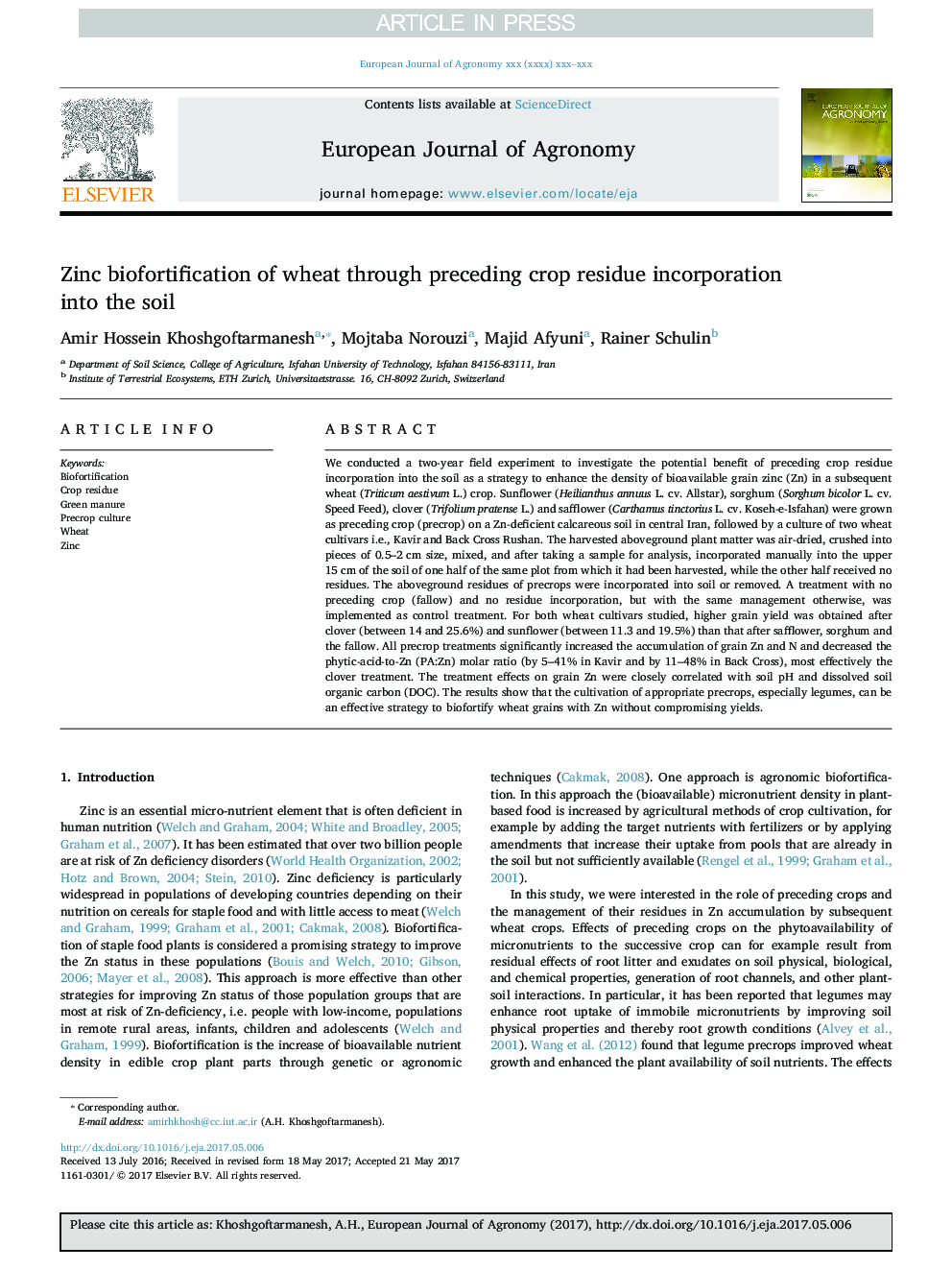| کد مقاله | کد نشریه | سال انتشار | مقاله انگلیسی | نسخه تمام متن |
|---|---|---|---|---|
| 5761227 | 1624435 | 2017 | 9 صفحه PDF | دانلود رایگان |
عنوان انگلیسی مقاله ISI
Zinc biofortification of wheat through preceding crop residue incorporation into the soil
ترجمه فارسی عنوان
بیوفایت زدایی از گندم از طریق افزودن بقایای محصول به خاک
دانلود مقاله + سفارش ترجمه
دانلود مقاله ISI انگلیسی
رایگان برای ایرانیان
کلمات کلیدی
موضوعات مرتبط
علوم زیستی و بیوفناوری
علوم کشاورزی و بیولوژیک
علوم زراعت و اصلاح نباتات
چکیده انگلیسی
We conducted a two-year field experiment to investigate the potential benefit of preceding crop residue incorporation into the soil as a strategy to enhance the density of bioavailable grain zinc (Zn) in a subsequent wheat (Triticum aestivum L.) crop. Sunflower (Heilianthus annuus L. cv. Allstar), sorghum (Sorghum bicolor L. cv. Speed Feed), clover (Trifolium pratense L.) and safflower (Carthamus tinctorius L. cv. Koseh-e-Isfahan) were grown as preceding crop (precrop) on a Zn-deficient calcareous soil in central Iran, followed by a culture of two wheat cultivars i.e., Kavir and Back Cross Rushan. The harvested aboveground plant matter was air-dried, crushed into pieces of 0.5-2Â cm size, mixed, and after taking a sample for analysis, incorporated manually into the upper 15Â cm of the soil of one half of the same plot from which it had been harvested, while the other half received no residues. The aboveground residues of precrops were incorporated into soil or removed. A treatment with no preceding crop (fallow) and no residue incorporation, but with the same management otherwise, was implemented as control treatment. For both wheat cultivars studied, higher grain yield was obtained after clover (between 14 and 25.6%) and sunflower (between 11.3 and 19.5%) than that after safflower, sorghum and the fallow. All precrop treatments significantly increased the accumulation of grain Zn and N and decreased the phytic-acid-to-Zn (PA:Zn) molar ratio (by 5-41% in Kavir and by 11-48% in Back Cross), most effectively the clover treatment. The treatment effects on grain Zn were closely correlated with soil pH and dissolved soil organic carbon (DOC). The results show that the cultivation of appropriate precrops, especially legumes, can be an effective strategy to biofortify wheat grains with Zn without compromising yields.
ناشر
Database: Elsevier - ScienceDirect (ساینس دایرکت)
Journal: European Journal of Agronomy - Volume 89, September 2017, Pages 131-139
Journal: European Journal of Agronomy - Volume 89, September 2017, Pages 131-139
نویسندگان
Amir Hossein Khoshgoftarmanesh, Mojtaba Norouzi, Majid Afyuni, Rainer Schulin,
